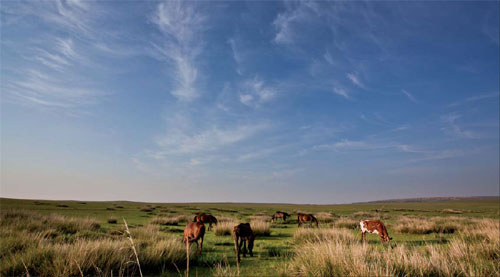Green getaway
Updated: 2012-08-17 07:40
(China Daily)
|
|||||||||
|
Xilamuren is one of the three most visited grasslands around Hohhot. Li Wei / For China Daily |
Regional capital offers taste of history and culture on the grasslands
Hohhot, which also means the Green City, is the capital of North China's Inner Mongolia autonomous region. The city lies between the Yinshan Mountain and the Yellow River and is 400 kilometers from Beijing.
It is the political, economic and cultural center of Inner Mongolia and home to 36 different ethnic groups including the Mongolian, Han, Hui, Tibetan, Orogen and Korean groups.
With distinctive ethnic features and a history of more than 2,300 years, Hohhot is a city rich in historical and cultural sites. The natural beauty of the surrounding grasslands also provides a convenient getaway from the hustle and bustle of urban living.
As a major economic hub of the region, Hohhot has been called the "capital of milk" because it boasts one of the country's largest dairy industries, which sprung from the expertise of local herdsmen.
Travelers can still make short detours from work to enjoy a wide variety of Mongolian traditions here, including horse riding on the grasslands as well as displays of archery and wrestling.
The best time to visit Hohhot is from April to October, while the best time to go horse riding is from mid-July to early September when the grasslands are at their greenest.
Here are some places worth visiting:
1. Dazhao Temple
Hohhot is home to more than 50 temples and one of the most noteworthy is Dazhao, which is also referred to as the Silver Buddha Temple because of a huge silver Buddha statue that sits inside the building. With a history of more than 400 years, it is one of the oldest temples in Hohhot that is still in good condition.
The temple is a well-known tourist attraction because of the impressive buildings, intricate statues and fine collection of Buddhist scriptures among many other religious relics.
Each year, the temple attracts people from all over the region and beyond to worship.
2. Zhaojun Tomb
This tomb is located 9 kilometers from the southern suburbs of Hohhot. It is a large, man-made, earthen pyramid-shaped mound, 33 meters high and crowned by a pavilion on its summit.
It was built to commemorate Wang Zhaojun, who was considered one of the four most beautiful women in ancient China and remembered for her sacrifice in leaving the court of the Han Dynasty's (206 BC-AD 220) Emperor Yuan to seal a strategic marriage with the ruler of the powerful Central Asian Xiongnu tribe.
The tomb was built to commemorate Wang's contributions to strengthen the ties between the Han and Xiongnu. Various statues and steles praising her selfless act to unite the Chinese people can be also found on site.
3. Grasslands
One of the most precious assets of Inner Mongolia is its wide expanse of grassland and that is also the main reason for many visitors to the area.
It is possible to visit one of the grassland areas on the outskirts of Hohhot in one day, but it is far better to spend a night or two in a Mongolian ger or yurt to enjoy the local milk tea and listen to the beautiful songs played by local herdsmen with their traditional musical instruments.
Visitors might find themselves taking part in a campfire party to sing and dance with the local people under the starry skies.
Xilamuren, Gegentala and Huitengxile are the three most visited grasslands arund Hohhot.
4. Five-Pagoda Temple
This Buddhist temple stands out with its elaborate structure, made up of five small pagodas built together on top of its base and painted in green and yellow.
The temple was constructed from 1727 to 1732 and images of its 1,563 Buddhas were vividly carved into the walls of the five distinct square pagodas.
The structures are regarded as representative of the architectural achievements of the Qing Dynasty (1644-1911).
Eating and drinking
Hohhot's delicacies reflect the influence of its Mongolian ethnic group. Mutton dominates menus and is a must try for all visitors. Mongolian people are also very good at making various kinds of dairy products such as cheese, yoghurt and salty milk tea.
First-time visitors should also try the local fried noodles and rice as well as camel meat mince pies.
Many watering holes offer some version of the traditional herdsmen's fermented mare's milk and the local baijiu firewater.
China Daily
(China Daily 08/17/2012 page22)

 Relief reaches isolated village
Relief reaches isolated village
 Rainfall poses new threats to quake-hit region
Rainfall poses new threats to quake-hit region
 Funerals begin for Boston bombing victims
Funerals begin for Boston bombing victims
 Quake takeaway from China's Air Force
Quake takeaway from China's Air Force
 Obama celebrates young inventors at science fair
Obama celebrates young inventors at science fair
 Earth Day marked around the world
Earth Day marked around the world
 Volunteer team helping students find sense of normalcy
Volunteer team helping students find sense of normalcy
 Ethnic groups quick to join rescue efforts
Ethnic groups quick to join rescue efforts
Most Viewed
Editor's Picks

|

|

|

|

|

|
Today's Top News
Chinese fleet drives out Japan's boats from Diaoyu
Health new priority for quake zone
Inspired by Guan, more Chinese pick up golf
Russia criticizes US reports on human rights
China, ROK criticize visits to shrine
Sino-US shared interests emphasized
China 'aims to share its dream with world'
Chinese president appoints 5 new ambassadors
US Weekly

|

|








